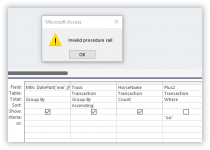I'm having problems getting the DatePart function to work. At present, when I run the query I get an error "Invalid Procedure Call". As far as I know I'm doing the right thing but obviously not completely. I've attached a picture of the QBE grid and also the SQL for the query in question.
I'm using my horse racing database to run this query. I'm using the Transaction table and I want to group results by Month.
The command I've issued in the first column is:
Format(Mth: DatePart("mm",[RaceDate])
the other columns are counting, summing and grouping.
I've looked online for answers but nothing helped, so I'm turning to the forum for help, please?
Thanks,
I just want to add that I would like to get the syntax for ordering the query in year and month. (I have records for Dec 2023 that I also want to include in the query), as in Dec 23, Jan 24, Feb 24 etc.
Can anyone help please?
I'm using my horse racing database to run this query. I'm using the Transaction table and I want to group results by Month.
The command I've issued in the first column is:
Format(Mth: DatePart("mm",[RaceDate])
the other columns are counting, summing and grouping.
I've looked online for answers but nothing helped, so I'm turning to the forum for help, please?
Thanks,
I just want to add that I would like to get the syntax for ordering the query in year and month. (I have records for Dec 2023 that I also want to include in the query), as in Dec 23, Jan 24, Feb 24 etc.
Can anyone help please?
Attachments
Last edited:

